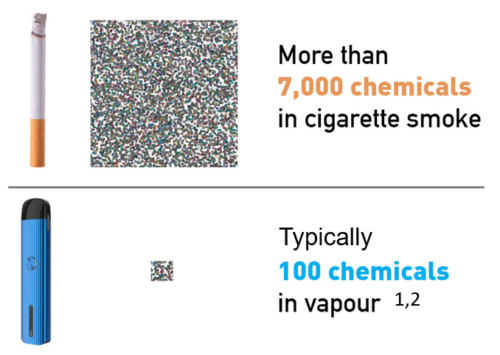
How safe and effective is vaping nicotine?
Posted on August 22, 2023 By Colin
I GAVE A PRESENTATION at Grand Rounds at St Vincents' Hospital, Darlinghurst today on the safety and effectiveness of vaping nicotine. Here is a short version of the key messages.
Is vaping effective?
The latest Cochrane review of 6 randomised controlled trials (November 2022) found that vaping was 63% more effective than nicotine replacement therapy. (Hartmann-Boyce 2022) Cochrane studies are the highest level of evidence that a treatment is effective. It found that if 100 smokers use NRT, 6 will quit. With vaping, 8-12 will quit. The quality of evidence for this conclusion was high, the highest level of certainty.

"Triangulation" makes this finding more certain. This involves considering a wide range of study types with different strengths and weaknesses. These studies all point to the same conclusion, strengthening the evidence that vaping is an effective quitting aid. They also show that vaping works in the real world setting, not just in a controlled trial setting.

Other study types include
- Observational studies (Goldenson 2021; Adriaens 2021; Kotz 2022)
- Population studies (Chambers 2022; Zhu 2017)
- Declines in national smoking rates (ONS 2022; NHIS 2022)
- Studies of ‘accidental quitting’ (Kasza 2021; Foulds 2022)
- Naturalistic randomised controlled trials (Carpenter 2023)
Population studies show very compelling evidence that vaping is increasing quit rates and reducing smoking. After vaping was legalised and regulated in New Zealand, the adult rate smoking declined by an unprecedented 33% over the next 2 years. (NZHS 2022) There were no other significant changes in tobacco control during that time and the decline was mainly attributed to the uptake of vaping.

In Australia where vaping is effectively banned, during the same 2-year period from 2020-22, the adult smoking rate increased by 4.5%. (DHAA 2023)
Is vaping safer than smoking?
Almost all of the harm from smoking is caused by over 7,000 chemicals released from burning tobacco. Vapes heat a nicotine solution to produce a liquid aerosol with around 100 chemicals (Margham 2016; Sleiman 2016). These chemicals are mostly less than 1% of the concentration found in smoke. (PHE 2018; Goniewicz 2014)

Smokers who switch to vaping also have substantially reduced biomarkers (toxic chemicals in the body) (Hartmann-Boyce 2023; OHID 2022) and have improved health. Studies have shown improvements in:
Asthma (Polosa 2016), COPD (Polosa 2020), blood pressure (Polosa 2016; Farsalinos 2016), muco-ciliary clearance (Polosa 2021), respiratory infections (Miller 2016), lung function (Cibella 2016), respiratory symptoms (Luchiarri 2020; Hajek 2016), cardiovascular markers (George 2019; Berlowitz 2022), gum disease (Yang 2020).
 The England Government recently commissioned a comprehensive, 1500-page systematic review of vaping and concluded that “vaping is not risk-free but poses only a small fraction of the risks of smoking” and is at least 95% less harmful. (OHID 2022)
The England Government recently commissioned a comprehensive, 1500-page systematic review of vaping and concluded that “vaping is not risk-free but poses only a small fraction of the risks of smoking” and is at least 95% less harmful. (OHID 2022)
Regarding long-term safety, the UK Royal College of Physicians also concluded that “Although it is not possible to precisely quantify the long-term health risks associated with e-cigarettes, the available data suggest that they are unlikely to exceed 5% of those associated with smoked tobacco products, and may well be substantially lower than this figure”. (RCP 2016)
A final word on nicotine. Nicotine causes dependence but is relatively benign. According to Public Health England, “Nicotine use per se represents minimal risk of serious harm to physical health”. (PHE 2018)
Nicotine does not cause cancer (IARC 2012; US SG 2014) or respiratory disease (US SG 2014) and is not a major cause of cardiovascular disease (Benowitz 2016).